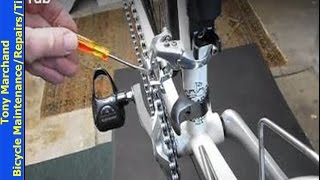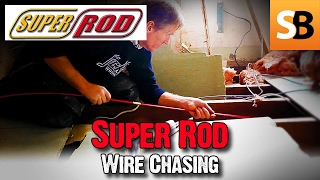Saturday, 27 December, 2025г.
















Где искать: по сайтам Запорожской области, статьи, видео ролики
пример: покупка автомобиля в Запорожье
When to Replace Bicycle Derailleur Cables and Housing to improve shifting
See link for more details on when to replace derailleur and brake cables and housing: https://docs.google.com/document/d/1PTk-fb07JWhUDLiCzq4xbyQci85BwNI9vS1jZMBwrt4/edit?usp=sharing
Cables are made out of stainless or galvanized steel and are under tension when you pull on the brakes or change gear. Despite what some say, bike cables (especially the derailleur cables) do wear over time. This will result in poor shifting and the possibility of snapping a cable. Some of this may be stretching of the cable but more likely may be related to small breaks in the cable weaving, especially at the points of maximum cable deformation such as the cable anchors that attach the cable to the derailleur or in the shifter. The idea is to change the cables before they break!
Derailleur Cables –What you might notice while cycling:
1. Skipping cogs when not shifting to the next cog.
2. Hesitation in shifting between cogs, soft feel when shifting, or jumping between cogs without shifting.
What to look for:
1. FIRST eliminate other causes of skipping or shifting hesitation:
a. Make sure that the rear derailleur is aligned properly, the upper pulley wheel should line up in the middle of the chain.
b. The cassette is free of dirt and gunk.
c. The bottom bracket cable guide (that guides the cables under the bottom bracket) is free of mud and dirt.
2. Then look for fraying around the cable anchors. A frayed cable, especially near the cable anchor, suggests replacement is needed.
Fraying inside the shifters are more difficult (to check, shift to the smallest chain ring and smallest cassette cog, release the cable anchor, hold back the shifter with a Velcro tie and move the cable out of the shifter). Cables should be inspected for fraying, especially at the shifter, at least every 1000 - 1500 miles (see summary). Your shop can help you here!
3. Check for cracks in shift housing suggesting that cable and housing should be replace.
4. If all looks well, try adjusting the barrel adjusters for optimal shifting. If you can't adjust the shifting or you take the bike out cycling only to have the problem recur after few rides, it's probably time to replace the derailleur cable.
Brake Cables - What you might notice while cycling:
1. When braking is no longer smooth or they feel "sticky" or "sluggish", it's time to replace the brake cables (and housing).
2. Cracks in the brake housing.
Summary: How often should I replace cables & housing if I'm not having any problems?
When to replace bicycle derailleur cables and housing is a hotly debated item when you examine the various bicycle forums on the internet. I looked at this with my trusted expert at the Clinton Bicycle Shop in Clinton, NJ. He, like myself, is an advocate of preventive maintenance before you get stuck at the side of the road on a country road.
Cables: Cables should be inspected for fraying, ESPECIALLY AT THE SHIFTER, at least every 1000 - 1500 miles. How often you replace the derailleur cables depends on whether you have a 10 or 11 speed and whether you have a first generation Shimano (housing comes out the side of the shifter and presents more breakage problems than most), SRAM / second generation Shimano (housing is under the handlebar tape) or Campagnolo (note: 11 speed Shimano cables are polymer coated). Your local shop can give you advice in this area. Sometimes you can predict that the cables need changing when shifting feels soft or the chain starts jumping between cassette cogs despite adjustments of the barrel adjusters or adjustments on your work stand. For me, I know my cables will usually last 2000 - 2500 miles and will change both front and back derailleur cables; earlier if I note fraying or shifting problems described above (10 speed, second generation Shimano). Better to be safe then breaking a cable on a steep uphill (which can spell disaster). At the time I'm checking derailleur cables, I'm also checking braking cables. Brake cables (along with the brake housing) should probably be replaced every 2 to 3 years to prevent problems and allow for smooth braking.
Housing: Change the REAR part of the derailleur housing (at the back) every time I change the rear derailleur cable. It's close to the ground and picks up a lot of dirt and gunk. THE REST of the derailleur housing holds up better and should probably be replaced every 2 years or 5000 - 7000 miles - EARLIER IF you note cracking, wear or discoloration to the housing. A lot depends on whether you ride in the winter, wet weather, or gravel or dirt roads. You should always inspect your brake housing for cracks or wear every time you check your cables. Brake housing should be replaced when you replace your brake cables every 2 to 3 years.
There is no complete rule of thumb. For me, I like to be pro-active and prevention is the name of the game
Теги:
bike cables cables bike derailleur cables wear poor shifting change bicycle cables bicycle bicycle cables cycling shifting skipping derailleur chain bottom bracket fraying frayed cable replacement chain ring cog cassette maintenance replace cable housing cable derailleur cable brake cables road bike mountain bike replace cables replace housing bike maintenance fix repair bicycle repair shift how to gear cables replace gear cables grime
Похожие видео
Мой аккаунт


 У вашего броузера проблема в совместимости с HTML5
У вашего броузера проблема в совместимости с HTML5


